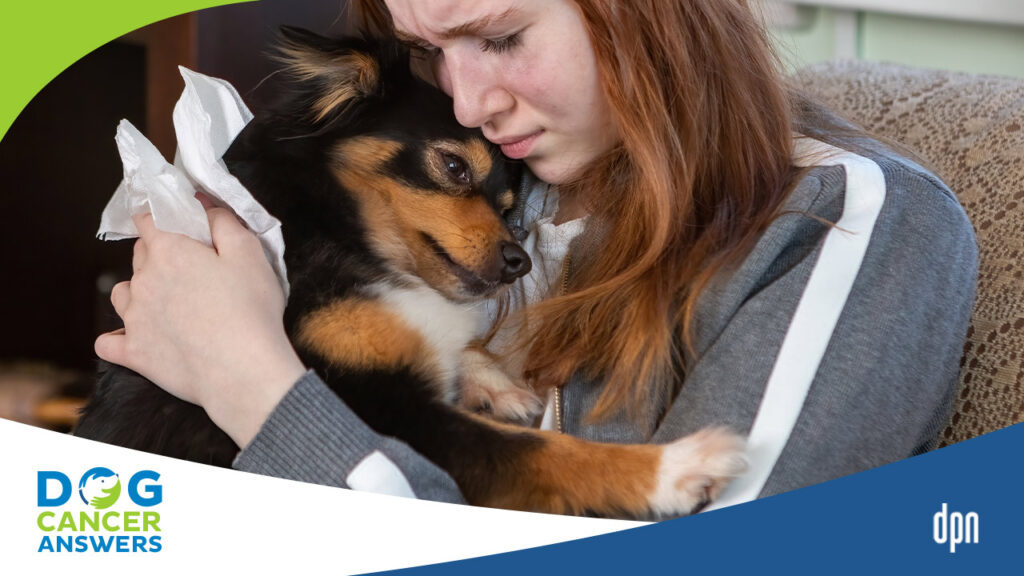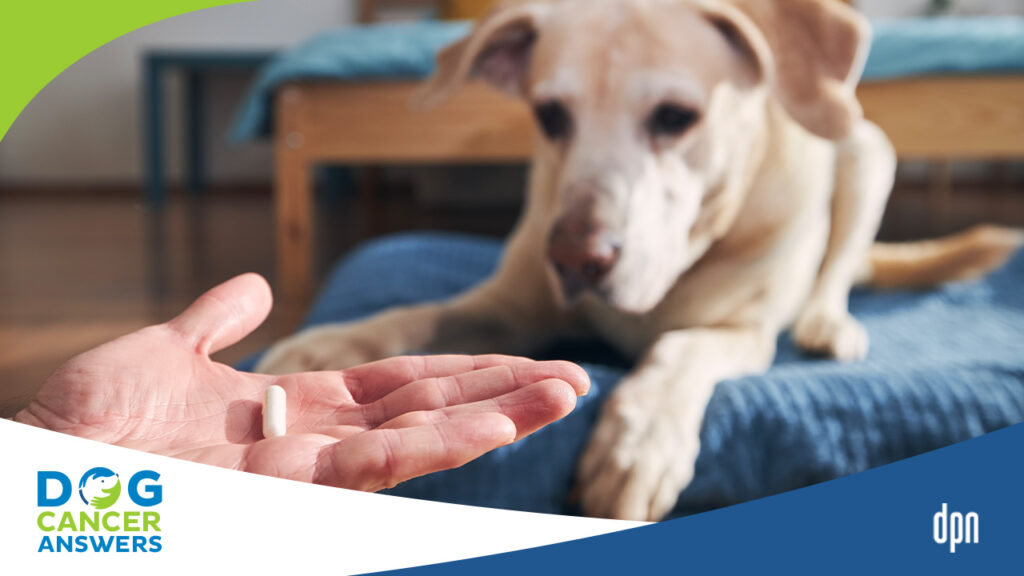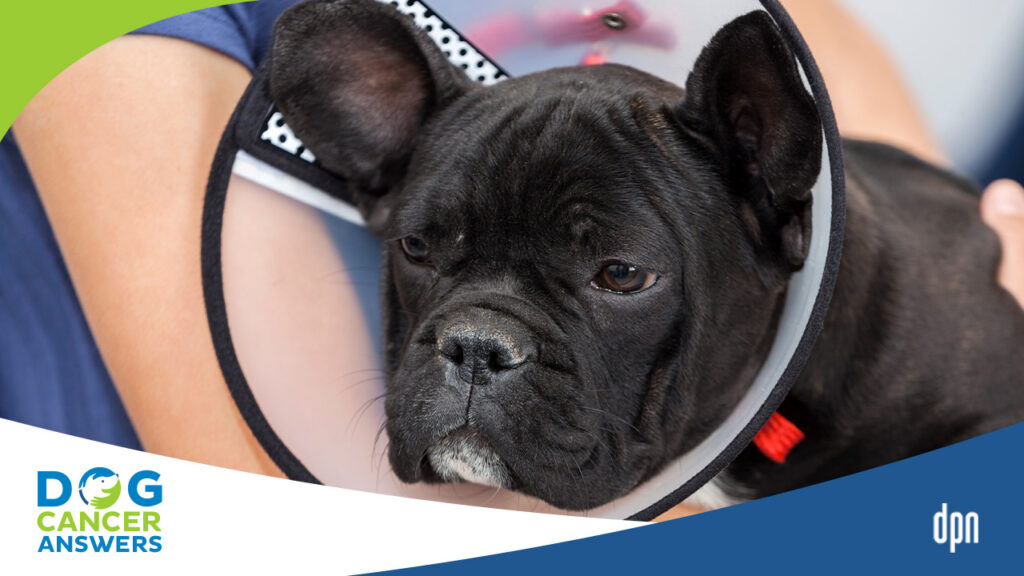Pain Management for Dogs
While pain is often along for the ride when it comes to cancer care, there are many options and recent advances to help owners manage this challenging side effect.
Key Takeaways
- There are many different medications, supplements, and physical therapies available to relieve your dog’s pain. A combination of these is usually the most effective.
- It is not recommended to give your dog any human pain medication. Most are either ineffective or downright dangerous. Instead, ask your veterinarian for a prescription pain medication made for dogs, and options for alternative pain control.
- Depending on the type of pain your dog has, there is a lot you can do at home. Ask your veterinarian for information on massage, passive range of motion exercises, hydrotherapy, and other home remedies.
- Depending on your dog, the pain level, and the type of pain, it can be hard to tell if your dog hurts. In general, dogs in pain may show abnormal behaviors such as panting, restlessness, limping, guarding a certain area of the body, snapping at others, and vocalizing.
- Crying and whimpering may not be good indicators of whether or not your dog is in pain. Some dogs may hide their pain or may just be so used to it that they don’t cry out or show many symptoms. When in doubt, it’s better to treat for possible pain than to ignore a new strange behavior in your dog.
Pain Serves a Purpose, Unless It Doesn’t
Pain (sometimes referred to as nociception) happens when your dog’s body is damaged in some way, triggering signals that travel to the brain through the neurons, synapses, and spinal cord.
While no one likes pain, it does serve a purpose. Pain signals are often thought to be protective, such as moving your hand away from a hot stove or your dog leaving your cat alone after getting scratched. This type of protective pain is called adaptive pain.
There is another type of pain we talk about in veterinary medicine and that is maladaptive pain. Maladaptive pain does not serve a purpose – it just hurts and makes your dog miserable. Maladaptive pain is often a result of chronic painful processes being out of proportion to the actual tissue damage.
Types of Pain in Dog Cancer
Dogs with cancer might experience pain for a variety of reasons:
- The tumor itself causing pain
- Side effects of the cancer disrupting body function
- Side effect of treatment
- Completely unrelated to their cancer – pain from arthritis, bad teeth, or an injury
There are many ways to describe pain. Your veterinarian may categorize your dog’s pain into different types according to where the pain signals are coming from.
- Visceral pain comes from the internal organs or the lining of the abdominal cavity.
- Somatic pain comes from the muscles, bones, or skin.
- Neuropathic pain comes from damaged nerves.
All of these types of pain can cause significant discomfort. However, because these types of pain come from different places and travel different pathways along the spinal cord, they are treated in different ways.
This is why dogs that have abdominal tumors or lymphoma are often treated slightly differently than animals that may have had a forelimb amputation due to osteosarcoma.
Pain comes in many different forms and just like the multiple pathways taken by pain, a multimodal approach to pain management (using both drug and non-drug methods) tends to work best.
Why Dogs with Cancer Have Pain
If your dog with cancer seems painful, you will of course want to figure out why. The pain could be caused by the cancer itself, cancer treatments, or a completely unrelated reason. Ask your veterinarian for help with this, especially if you are not sure.
Pain from the Cancer
Most cancers are not particularly painful, but bone cancer is the most infamously painful cancer – bone pain hurts.
Tumors can also be painful if they burst open, ulcerate, or are damaged.
For many other cancers, pain comes from the tumor getting in the way. For example, if a soft tissue sarcoma grows behind your dog’s elbow and blocks your dog from walking normally, this will eventually cause discomfort. Oral tumors can hinder normal eating or are painful if your dog accidentally bites into them.
Pain from Cancer Treatment
If your dog has surgery to remove a tumor, there will be some pain during the healing process. Biopsies will also have some pain. Surgical pain can be controlled and should go away as your dog heals.
Radiation therapy is not painful, but your dog may experience tissue necrosis and sloughing. These side effects are painful.
Some chemotherapy drugs can cause discomfort such as nausea and bladder inflammation.1
What to Do About Pain Management for Dogs
One of the first things you need to do is schedule time to sit and talk with your veterinarian or veterinary technician. In today’s times we have multiple tools to recognize pain, fear, and stress in each animal.
Many research reviews have shown that we can use some facial recognition and body language cues to clue us in as to what your pup may be feeling. For example, a dog that continuously grimaces, squints, pants excessively when at rest, or chews/licks one area is exhibiting signs they may be in pain.2
When to Call Your Vet
Pain can become an emergency situation if it becomes so severe it changes his or her normal behavior.
Severe pain may cause a dog to react aggressively to any touch, which can be dangerous for everybody. If the pain is severe enough your dog may be extremely lethargic and unwilling to move, even for meals or bathroom breaks. If you see any of these signs it is important to call your veterinarian’s office and be seen as soon as possible.
It can be difficult sometimes to tell if your dog is in pain. The Colorado State University Dog Pain Scale can be helpful if you are not sure.4
Options for Pain Management for Dogs
The list of pain control options for dogs nowadays seems endless, and it can get complicated. It’s important to work together with your veterinarian to use therapies and modalities that have been shown to be effective and safe for your pup.
We know the best course of treatment is through a combination of medications such as anti-inflammatories, anti-nausea medications and nutraceuticals combined with physical therapy modalities such as massage, hydrotherapy, and acupuncture.
For more help managing your dog’s pain, go to the website of the International Veterinary Academy of Pain Management.3 They are a great resource for the variety of pain management therapies and to find certified veterinary pain practitioners in your area. Certified veterinary pain practitioners are folks that specialize in pain management and can work together with your veterinarian to create a comprehensive pain management plan that works best for your pet.
Here are a few other ways you can help your pet live their best and pain free days:
- Acupuncture: Ask your veterinarian if acupuncture is an option for your dog. Many general practice veterinarians are certified and trained in acupuncture or know someone in your area. Set up a consultation with them right away.
- Acupressure: If acupuncture is a good option for your dog, ask the doctor if she can train you in acupressure (using digital pressure at acupuncture points to stimulate a response). This can be done in between acupuncture appointments to prolong the effects. These exercises can be performed at home while you and your pup are watching TV together.
- Massage and Passive Range of Motion: These are simple ways you can help your dog feel better and move her joints in a way to prevent joint stiffness and muscle pain. Working with your veterinarian or a certified canine rehabilitation practitioner, you can learn techniques to perform these exercises at home without a stressful car ride into the veterinary office.
- Hydrotherapy: Ask your veterinarian if this is an option, and ways you can do this at home. Using a bathtub filled to the appropriate depth, you can bond with your dog while providing pain relief on joints and muscles.
Is Pain a Sign of the End?
Pain itself isn’t a sign your dog is dying, but it does lower quality of life. In general, dogs who have cancer either pass away from the cancer itself spreading to other parts of the body, or because their quality of life suffers so much that their humans choose euthanasia.
Pain and discomfort are common in many types of cancer and can be normal side effects of some cancer treatments, including some chemotherapy drugs, surgery, and sometimes radiation. Knowing how to recognize signs of pain, when to call your veterinary team, and the willingness to try a multimodal approach provides better outcomes and thus a greater quality of life for your pet. If pain is managed, dogs can often live comfortably despite their cancer diagnosis.
If your dog’s pain can no longer be managed, that may influence your end-of-life decision making. Dogs who are suffering do not need to feel that way. Humane euthanasia is an option you can discuss with your family and with your veterinarian, if you feel your dog is in pain and different options have been tried.
Topics
Did You Find This Helpful? Share It with Your Pack!
Use the buttons to share what you learned on social media, download a PDF, print this out, or email it to your veterinarian.









